Author Bios: 8 Best Practices
Author Bios. You have definitely seen those around. Putting some thought into your author bio for your social media, blog, or website is essential to your marketing strategy, but writing one can be tricky. The reality is your author bio defines you in the eyes of agents, editors, readers, journalists, bloggers, and everyone else who might want to do business with you.

Author Bios. You have definitely seen those around. Putting some thought into your author bio for your social media, blog, or website is essential to your marketing strategy, but writing one can be tricky.
The reality is your author bio defines you in the eyes of agents, editors, readers, journalists, bloggers, and everyone else who might want to do business with you. You may also be a beginner, and the word “author” may seem pretentious to you.
But you still need an author bio. There is always a possibility of one of your blog entries being picked up by an editor or website that wants to publish it. You want to be ready. Writing a good author bio can be challenging because how do you do it in a few short lines?
It is impossible to follow a one-size-fits-all formula for author bios, but here are some tips on getting started. We have also provided examples and recommendations to help you. Let’s dive in!
What is an Author Bio?
An author bio is a brief paragraph in which you offer information about yourself, such as your work experience, professional interests, or hobbies. To help humanize you, the writer, author bios are frequently displayed next to a professional photo or headshot of the author.
While there is no predetermined word count for a bio, you should aim for a paragraph or two.
The purpose of an author bio is to provide a brief background on you, the author, and demonstrate why you were qualified to write your book or article in the first place. An author bio, in essence, provides you with credibility among your numerous readers and allows you to interact with future readers and encourage them to read more of your work.
In your author bio, for example, you may demonstrate that you know what you are talking about and are an expert in your industry by describing your previous schooling, work experience, and talents.

Another advantage of a well-written, concise bio is that it humanizes you. Your bio should be filled with personality and convey to your readers who you are. For example, your author bio could include a statement indicating how many works you’ve previously authored. Then, add another phrase explaining why you started writing in the first place.
Finally, you may talk about your family, your interests outside of writing, and any formal schooling, awards, or certifications you have received in your writing career.
A well-written bio does not require you to be a maestro of creative writing. Your author bio should simply persuade readers that you are more than just an author or some faceless person who published an internet piece — you are a person.
Why You Need Author Bios for your Website
The website author bio is essential for SEO in ways you may not have considered.
At first look, the website author’s bio may appear to be a small piece of text. It’s modest and frequently out of the way, and on some sites, it’s even pushed aside into its profile page, where it may be isolated from the rest of the site.
These types of “always present” material are frequently minimized in Google’s algorithm because it would otherwise be simple to update one piece of content to add dozens or hundreds of connections throughout an entire site.
Obviously, that would be immediately misused.
While it is true that links in an author’s bio are not particularly vital for SEO, everything else in the author’s bio is far more critical. We know Google is concerned. Consider the last few years.
Recall Google Authorship when they sought to persuade everyone to sign up for Google Plus accounts to consolidate their author influence into a single property? It didn’t work, so they retired it, showing how much they care about it.
A recent Google upgrade and its new emphasis on EAT score provides additional evidence. EAT is the Expertise, Authoritativeness, and Trustworthiness metric that Google currently uses to rank websites when its human raters look at them.
How Do You Create an Author Bio?
Take an insightful peek into our carefully prepared tips.
1. Write in the Third Person
Writing in the third person makes a writer appear more knowledgeable and just reads better than writing a biography about oneself. Although it may seem a little self-congratulatory, it increases credibility.
2. Keep the Bio Short and Concise
An excellent author biography should be concise. If you browse other websites, you’ll notice that most author biographies online fall between 50 and 100 words. Additionally, the CMS (content management system) may have established a specific quantity of space.
3. Include Information on Job Title and Function
You are giving your writing credibility by mentioning your position and job duties. If you wrote about SEO, having expertise in the subject would give you more credibility than if you wrote about PPC. Although SEO professionals may wear many hats, knowing if a person is a generalist or specialist gives additional subject knowledge when reading an author’s bio.
4. Include Your Experience
- Describe your years of experience working in the relevant fields below.
- Authored works.
- Citations.
- Titles or degrees.
- Speaking engagements at conferences and other events.
- Media attention.
- Previous jobs
5. Highlight Expertise & Trustworthiness
Describe your knowledge of the subject you are writing about. For instance, if you are writing about health, letting your audience know about your experience in the field will give you much more credibility than an article on the same subject published by a blogger or copywriter. Not only is it vital for SEO, but it also helps users recognize you as a reliable source on a specific topic by stating your experience in the author’s bio.
6. Include Social Media Profiles
Another great approach to provide readers access to more of your information is by including social media links on your author pages. You may link your personal or professional website and social media accounts. Additionally, it can assist others in finding your social media handles so they can tag you or your business in their postings. Moreover, it provides a way for readers to carry on the conversation.
7. Include a Good Photo
The reader can be shown visually that there is a natural person behind the words they have read by including a photo of yourself in your bio.
8. Inject Your Personality
Sharing a personal passion or a humorous story can make an author’s bio page more intriguing and engaging, even though it’s not strictly necessary for SEO. The most excellent place to convey too much personal information is generally not in your bio because readers might only be tangentially interested in your personal life.
Author Bio Best Practices
Optimizing an author credit page on a different URL than authors are present on a single about page can help with search engine optimization. Let’s look at what The Harvard Business Review is doing. HBR lists its authors on a separate “about us” page.
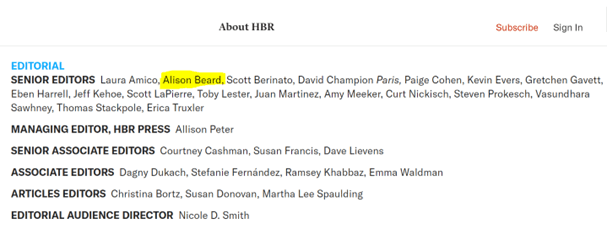
In the example of Alison Beard, Google indexes the author’s name first, so any search for her would be for articles she published.
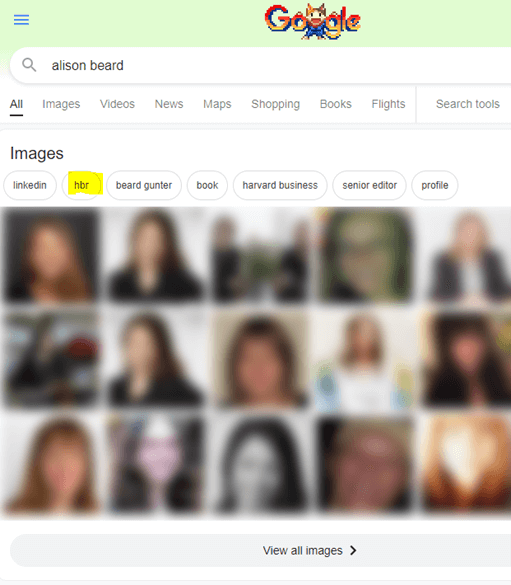
For example, Google may have linked Alison Beard and HBR on its knowledge graph, but it’s unclear which person should rank first on Google. Based on our in-depth search, the featured snippet appears on a third-party website.
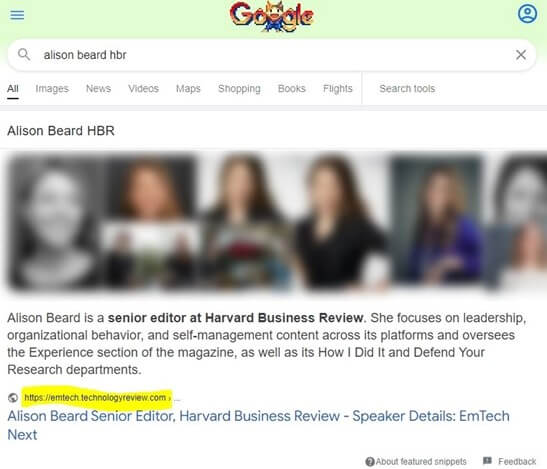
However, reading more articles by Alison Beard from an external website is not advisable.
Allow Author Bio Pages to Be Indexed
The belief that author bio pages should not be indexed is popular. The page will typically not be indexed if the domain configures it with the robots.txt file.

The internet is full of people looking for writers or journalists. Readers follow them, and some even sign up for their personal newsletters.
This kind of traffic is consistent and uses navigational searches.
You should ensure your webpage is indexed and optimized, even if the emphasis is on Author Bio Page SEO. Authors knowledgeable in their subject matter will do better on their webpage when it’s indexed and optimized.
On-Page SEO Tips for Author Profile Pages
The author’s name should be the primary keyword for author profile pages. It is generally recommended that blogs allow their posts to be indexed and optimized, especially if the blog’s purpose is mostly Author Bio Page SEO.
For instance, using Katharine Murphy from The Guardian as an example:

The Guardian does an excellent job of linking authors on their website, from the bylines on articles to their individual pages showcasing their work.

Additionally, in their author HTML sitemap:
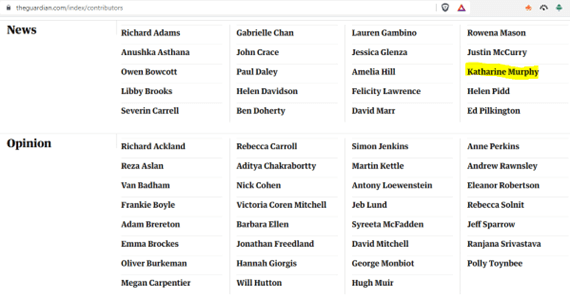
They also contribute by linking back to this page from the bottom of their page under “all writers.”
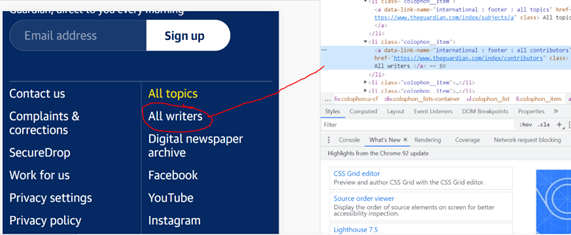
Use Structured Data
Before an article can make it to the top news stories, it needs to have Google’s standards. One of those standards is article-specific structured data usage.
With the release of Google’s Publisher Center, you no longer need to manually submit sites to Google News. This process can now be automated and takes just minutes.
Previously, authorship was only used for publishers. Now it can be used for sites that provide news material. However, being eligible for Google News and getting included is different.
Google News inclusion is also not a point in whether or not you will be included in Google News. If structured data improves your EAT, you may benefit from its utilization by Google’s Knowledge Graph.
Examples of the Best Author Bios
If you decide to write an author bio, make sure it’s formatted well. The following examples are great ideas for inspiration.
1. Uniformly Branded: G2

G2 uses a bright red background for all their company headshots, which benefits the company and individual authors. This specific color serves as uniform branding throughout the company and also alerts readers to content originating from these authors.
2. Author Name + Headshot: Buffer

Buffer performs an excellent job at balancing several aspects in a constrained area. Their understated “read time” glasses emblem and the understated circle outline around their headshots are my favorites.
Buffer strikes a balance between the different aspects of the page. Our favorite parts of their design are the “read time” glasses and the interesting choice to use headshots with an understated circle outline; they do a good job of balancing.
3. Author Name Only: Makespace

The hero image and blog title provides a sharp, complementary contrast to the Makespace author bio.
4. Creative Spin: Signal vs Noise

To put a face to the name, you can imagine every author pictured as an original. Or, for camera-shy or remote authors, you can use Signal v. Noise‘s technique of drawing every author.
5. Personality: Rover
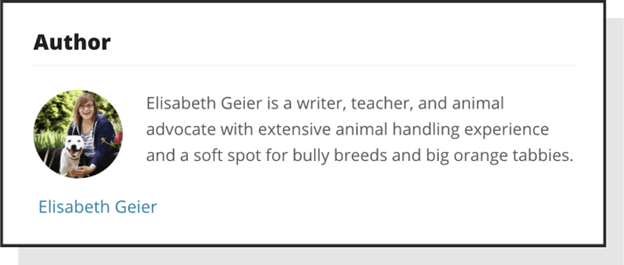
It’s essential to show team members love in their bio copy. Rover has employees who love animals and regularly showcase their passion in the workplace.
Companies make their staff more relatable by giving them space to be creative with their bios. The team at Rover does an excellent job of displaying the unique traits that set it apart from other companies.
Wrapping Up
Keep in mind that every bio is a little different, and no bios are perfect. Your bio will evolve as you create more publications and receive more recognition. There is not an exact formula for making a bio; these are all excellent suggestions.
When composing your author bio, you should be detailed, highlight your knowledge and experience, and humanize yourself. You can link to your social media accounts and include a profile photo.
In the end, it’s all about the reader and how you can meet their requirements, pique their interest, and maintain their attention in the best way possible.
It is vital for bios to be meaningful and to keep your readers in mind. However, it is still important to enjoy yourself and come across as a person rather than a soulless robot. We are happy to help you organize your website in the best way possible.
Your bio matters. People care. Make it matter.

Download Kadence Theme & Kadence Blocks To Build An Effective Websites
If you love to create compelling content with beautiful design, Kadence Blocks provides tools to be creative right in the native WordPress editor. Plus, enjoy tons of prebuilt content you can easily include in your site, including a wireframe library of blocks to get your started on your next web design. Great for inspiration and fast development!
Sign up now — Get SolidWP updates and valuable content straight to your inbox
Sign up
Get started with confidence — risk free, guaranteed
